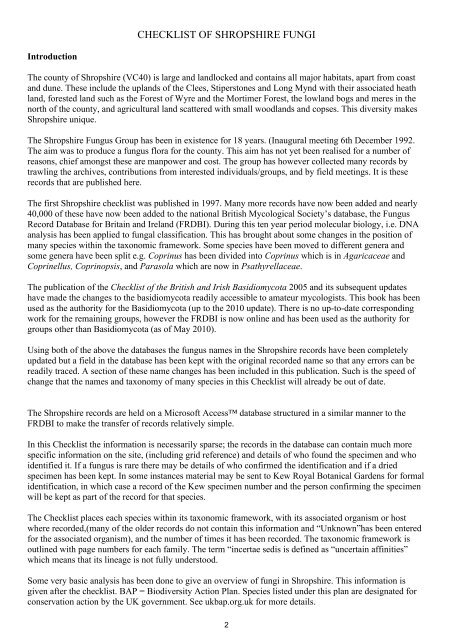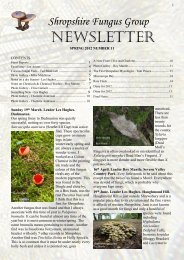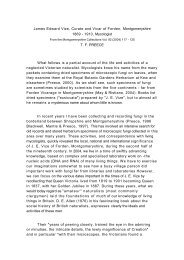The Checklist of Shropshire Fungi 2011 - Shropshire Fungus Group
The Checklist of Shropshire Fungi 2011 - Shropshire Fungus Group
The Checklist of Shropshire Fungi 2011 - Shropshire Fungus Group
Create successful ePaper yourself
Turn your PDF publications into a flip-book with our unique Google optimized e-Paper software.
Introduction<br />
CHECKLIST OF SHROPSHIRE FUNGI<br />
<strong>The</strong> county <strong>of</strong> <strong>Shropshire</strong> (VC40) is large and landlocked and contains all major habitats, apart from coast<br />
and dune. <strong>The</strong>se include the uplands <strong>of</strong> the Clees, Stiperstones and Long Mynd with their associated heath<br />
land, forested land such as the Forest <strong>of</strong> Wyre and the Mortimer Forest, the lowland bogs and meres in the<br />
north <strong>of</strong> the county, and agricultural land scattered with small woodlands and copses. This diversity makes<br />
<strong>Shropshire</strong> unique.<br />
<strong>The</strong> <strong>Shropshire</strong> <strong>Fungus</strong> <strong>Group</strong> has been in existence for 18 years. (Inaugural meeting 6th December 1992.<br />
<strong>The</strong> aim was to produce a fungus flora for the county. This aim has not yet been realised for a number <strong>of</strong><br />
reasons, chief amongst these are manpower and cost. <strong>The</strong> group has however collected many records by<br />
trawling the archives, contributions from interested individuals/groups, and by field meetings. It is these<br />
records that are published here.<br />
<strong>The</strong> first <strong>Shropshire</strong> checklist was published in 1997. Many more records have now been added and nearly<br />
40,000 <strong>of</strong> these have now been added to the national British Mycological Society’s database, the <strong>Fungus</strong><br />
Record Database for Britain and Ireland (FRDBI). During this ten year period molecular biology, i.e. DNA<br />
analysis has been applied to fungal classification. This has brought about some changes in the position <strong>of</strong><br />
many species within the taxonomic framework. Some species have been moved to different genera and<br />
some genera have been split e.g. Coprinus has been divided into Coprinus which is in Agaricaceae and<br />
Coprinellus, Coprinopsis, and Parasola which are now in Psathyrellaceae.<br />
<strong>The</strong> publication <strong>of</strong> the <strong>Checklist</strong> <strong>of</strong> the British and Irish Basidiomycota 2005 and its subsequent updates<br />
have made the changes to the basidiomycota readily accessible to amateur mycologists. This book has been<br />
used as the authority for the Basidiomycota (up to the 2010 update). <strong>The</strong>re is no up-to-date corresponding<br />
work for the remaining groups, however the FRDBI is now online and has been used as the authority for<br />
groups other than Basidiomycota (as <strong>of</strong> May 2010).<br />
Using both <strong>of</strong> the above the databases the fungus names in the <strong>Shropshire</strong> records have been completely<br />
updated but a field in the database has been kept with the original recorded name so that any errors can be<br />
readily traced. A section <strong>of</strong> these name changes has been included in this publication. Such is the speed <strong>of</strong><br />
change that the names and taxonomy <strong>of</strong> many species in this <strong>Checklist</strong> will already be out <strong>of</strong> date.<br />
<strong>The</strong> <strong>Shropshire</strong> records are held on a Micros<strong>of</strong>t Access database structured in a similar manner to the<br />
FRDBI to make the transfer <strong>of</strong> records relatively simple.<br />
In this <strong>Checklist</strong> the information is necessarily sparse; the records in the database can contain much more<br />
specific information on the site, (including grid reference) and details <strong>of</strong> who found the specimen and who<br />
identified it. If a fungus is rare there may be details <strong>of</strong> who confirmed the identification and if a dried<br />
specimen has been kept. In some instances material may be sent to Kew Royal Botanical Gardens for formal<br />
identification, in which case a record <strong>of</strong> the Kew specimen number and the person confirming the specimen<br />
will be kept as part <strong>of</strong> the record for that species.<br />
<strong>The</strong> <strong>Checklist</strong> places each species within its taxonomic framework, with its associated organism or host<br />
where recorded,(many <strong>of</strong> the older records do not contain this information and “Unknown”has been entered<br />
for the associated organism), and the number <strong>of</strong> times it has been recorded. <strong>The</strong> taxonomic framework is<br />
outlined with page numbers for each family. <strong>The</strong> term “incertae sedis is defined as “uncertain affinities”<br />
which means that its lineage is not fully understood.<br />
Some very basic analysis has been done to give an overview <strong>of</strong> fungi in <strong>Shropshire</strong>. This information is<br />
given after the checklist. BAP = Biodiversity Action Plan. Species listed under this plan are designated for<br />
conservation action by the UK government. See ukbap.org.uk for more details.<br />
2




